There
are usually three kinds of paper used
for Chinese calligraphy: Shuan Paper, Mian Paper, and Mao Bian Paper.
Many beginners often want to save time for ink grinding and cost of paper.
Practicing with grinded ink and Bamboo Paper or Xuan Paper is indeed the
fastest, time saving, and inexpensive way to make progress. Bottled ink does not
mean 100% ready to use without any grinding at all in most cases; Water Writing
Paper cannot replace the unique features of Xuan Paper.
The formal paper used for Chinese calligraphy and painting is called Shuan Paper ( 宣紙 ). Shuan ( 宣 ) Zhou is the name of the original place that is most famous for its production. Shuan Paper is made of many different plant fibers other than rice. If Chinese paper and books were made of rice, they would have been eaten by insects thousands of years ago.
In the nineteenth century when the Europeans wanted to get the trade secrets of Shuan Paper from China, they were misinformed it was made of rice. Hence, most people in the West have been calling it "rice paper" either as a misnomer or for convenience's sake. This widespread misnomer may cause the beginners or practitioners in forming a habit and inability to distinguish many other prevalent misnomers and misconceptions already widespread in learning Chinese Brush Arts (calligraphy, painting, and seal carving.) There are indeed many people outside Asia who have been choosing and using the wrong kinds of "rice paper." Some of them have been painting or writing for decades without being able to distinguish the different effects by using different kinds, grades, and brands of authentic Shuan Paper. Some may realize later that there are actually many kinds of Shuan paper such as mulberry paper, bark paper, gampi paper, sized or unsized paper, Single Shuan Paper, Double Shuan Paper, aged Shuan Paper, and etc. - they may regret wasting their time, efforts, and money by choosing the wrong paper and being unable to produce satisfactory texture strokes in Chinese Brush Painting or beautiful Chinese calligraphy strokes. They could have avoided these at first by not knowing it as "rice paper" or by not buying from unauthentic dealers who label various kinds of Asian paper simply as "Oriental Rice Paper."
|
This article was based on the statements by the heir of the Xuan Paper maker in Jing County, Cao Tiansheng ( 曹天生 ). Dr. Cao received his Ph.D. from the Political Science Research Center at the People's University in Beijing and was also once a historical committee member of the Chinese Paper Making Association. He is also the author of the book Chinese Xuan Paper ( 中國宣紙 ) that describes the papermaking history and industry of China. (http://siris-libraries.si.edu/ipac20/ipac.jsp?uri=full=3100001~!853381!0#focus) Suggested search keywords on Google: 安徽涇縣 + 青檀木
Qing Tang tree & paper making (video currently N/A)
Since the mid of 19th century, numerous spies from Europe faked into the villages of Jing County to learn about the secrets of making Chinese Xuan Paper. After these people went back to their own countries, they wrote and published how the Chinese made their Xuan paper. In 1909, a foreign country even took some samples of Qing Tang tree ( 青檀木 ) to their country, but the researchers cannot identify the tree because it's not grown in their country. After 1937, using the opportunity of invading China, they shipped some Qing Tang bushes to their country. But the climate there did not fit the tree to grow well. The paper made from the tree fiber was inferior. Later after China opened it's door, spying on the technique of making Xuan Paper became much easier. But no matter how other paper makers imitated the technique, no one can make the same Xuan Paper as made in Jing County. This is because the minerals in the water of the Jing County springs and the local climate for growing the special tree fiber are vital for the quality of the absorbency of the paper. Excellent places to shop for Cao Family Shuan Paper ( 曹氏宣紙 ) online:
|
Shuan Paper is suitable for the absorption of Chinese ink and colors and motions of Chinese writing and painting brushes. Its high quality feature makes it the best choice for formal Chinese calligraphy and painting artworks. If a work of Chinese calligraphy or painting is gifted, it is better to be done on Shuan Paper or silk to show politeness and respect. Shuan Paper, if preserved properly, can last at least 1,000 years.
Shuan Paper is the world famous paper noted for its resistance to aging and deterioration. The paper was first produced in Shuan Zhou, Anhui Province. Later Shuan Paper became the generic term used for various Chinese calligraphy and painting paper, even if the paper is produced outside Anhui Province. Shuan paper is soft and flexible and has just the right degree of absorbency for Chinese brush-and-ink calligraphy and painting, so the art and the material complement each other superbly to produce optimal results. The paper is available in different sizes, thicknesses, smoothness, and absorbency of water by being sized with different amounts of alum. Some kinds of Shuan Paper contain a basket-weave pattern that can become visible and form part of the texture with dry ink application.
Nowadays machine-made Shuan Paper for practice is available at lower prices than the traditionally handcrafted brands. However, with the lower grade of machine-made Shuan Paper, the calligraphy written on it will be inferior. That means the quality of the artwork will suffer at the compensation of prices. The compatibility between ink, brush, and paper must match in order to create high quality of Chinese calligraphy or painting artworks. In China's calligraphy forums, such as www.sf108.com, there are topics specifically dedicated to the discussions of paper and ink compatibility and absorbency issues related to brush motions. There are many brands of Shuan paper - some are thinner and others may be very thick. It is a personal preference or professional insight to choose one's favored brands or kinds. Selections of Xuan Paper depend on the calligrapher's insights, styles, brushes, writing speeds, ink qualities, sizes of Chinese characters, manufacturers' reputations, and many other factors.
Mian Paper is very popular for practicing Chinese painting and calligraphy. It’s cheaper than Shuan paper. Nowadays, manufacturers produce Mian Paper of long rolls that are a lot of longer than standard-sized Shuan Paper (usually 26 x 52 inches.) Mian Paper is usually called Cotton Paper by Chinese but it is not made of cotton. The reason why it is called Cotton Paper by Chinese is that when it is torn or scattered, the fibers look like cotton.
The so-called "Oriental Rice Paper" in sheets and especially rolls sold in many art stores outside Asia are usually Mian Paper. They are neither real Shuan Paper nor "rice paper," though the labels say it's made in certain Asian country. Its absorbency and function cannot be compared to those of Shuan Paper. Shuan Paper is rarely available in "uncut" long rolls, say longer than 52 or 80 inches.
Mao Bian Paper (Bamboo Paper) is cheaper than Mian Paper. Most beginners start practicing calligraphy with Mao Bian Paper with printed grids for positioning of strokes.
Like Shuan Paper, Mao Bian Paper also has a smooth side and a rough side. We can tell the difference by feeling the front side slippery and the back side rough with our fingertips. Most people prefer to write on the smooth side (i.e., the front side) of Mao Bian Paper.
Depending on the brands of Mao Bian Paper, to create the theoretical effects of Gi & Se ( 疾與澀 ), sometimes I practice on the rough side for certain brands of Mao Bian Paper and some Chinese calligraphy styles. This may help create more frictions with the brush hairs and generate more “internally frictional power” and visual effects. But when practicing with the slippery side of certain brands of Mao Bian Paper, we are just writing and not generating frictional and thrusting power going into the paper ( 力透紙背 ). In fact, many brands of Mao Bian Paper in the market today are very slippery since they are machine-made and the manufactures or businessmen do not study the theories of Chinese calligraphy. Yan Zhenqing ( 顏真卿 ) stated how his teacher Zhang Xu ( 張旭 ) passed to him the secrets of using a brush. He pointed out that Chinese calligraphy should look like drawing on sand with an awl ( 錐劃沙 ). ( 疾與澀 and 錐劃沙 are the cores of Chinese calligraphy theories.) Since sand is never slippery or smooth, it’s more reasonable to use the “rough side” for the theoretical ideal of 疾與澀 if the front side is really too slippery. "澀 Se" literally means "not slippery or unsmooth" and is one of the unique features of traditional Chinese calligraphy that distinguishes it from other cultures of calligraphy in the world.
If the brand of Mao Bian Paper is not too slippery, we may actually practice on the front side with the printed grids.
Practicing Kai Shu with Bamboo Paper and Grids
Mao Bian Paper may become very uneven after we have written on it. Some beginners tend to dip their brushes with undue amount of water and ink and make Mao Bian Paper even more uneven just right after writing a few strokes - then they throw the paper away and try another sheets... eventually or immediately they wonder whether they are talented enough to continue.
|
It's absolutely true that without learning to grind ink on the inkstone one can never be good at Chinese calligraphy and painting at historical masters' levels. Many people have complained how time consuming and tedious just to grind ink and decided to use the bottled ink which contains preservatives or chemicals that harm the brush hair and cannot create different shades and tonalities as compared with grinded ink. There are, of course, methods to grind ink in the least amount of time and efforts and also proper ways to dip the brush with ink to make to brush tip pointed and create beautiful strokes easier.
|
In fact, dipping brushes with ink and the preliminary preparation of ink grinding are as important as the Center Tip Principle and are closely connected to many other detailed principles and theories. (This is absolutely different from water color painting or Western calligraphy.) Grinding ink and dipping the brushes with ink are often neglected by beginners without close supervision of a teacher. For most Kai Shu (especially Tang Kai), Li Shu, and Zhuan Shu styles, the brushes need to dipped "linearly" - one direction at a time to make sure the hairs are straight and groomed; otherwise, the strokes will not be satisfactory no matter how talented we are!
One way to make Mao Bian Paper even and flat after writing is to stick it to the bathroom mirror during or after a hot shower. Another better way is to spray it with water or steam it and flatten and smooth it with a wide brush.
Smoothed Bamboo Paper after writing 托平後的毛邊紙
After one has practiced with Bamboo Paper and grids, s/he should continue with Xuan Paper without grids. Bamboo Paper with grids may not be suitable for practicing Hsin Shu and Tsao Shu since the grids may confine the artistic expression and freedom as required in cursive writing.
Water Writing Paper ( 水書紙 ) or called "magic paper" let students practice with water instead of ink. A student may dip the brush with water and write on it. When the water dries in about one minute, writing disappears and the paper can be used repeatedly for nearly 2,000 times if it is used with the right amount of water and clean brush. However, if we don’t use clean brush for this practice, ink residue may stay on Water Writing Paper permanently.
Since the densities of ink and water are quite different, if the student is getting used to this convenience, s/he must also adapt to real ink and paper later.
Samples
of Water Writing Paper (Water Writing Paper may not be suitable
for practicing Kai Shu, Li Shu, and Zhuan Shu in slower motions)
|
|
Ink sticks from a particular maker are especially prized. There are several different colors: blue-black, brown-black, and a true black, depending on the part of the pine tree that has been used. The ink sticks are made from pine-soot ( 松煙 ) or oil-soot ( 油煙 ) and resin. It is the amount of resin that makes the ink sticks so variable. A flesh ink stick will have a pleasant smell, often of sandalwood or pine, or some Chinese herbs. Since top quality ink sticks may also contain some herbs, they were also used to treat diseases in ancient China.
For practicing Chinese calligraphy, we usually use the pine-soot ink sticks. As for Chinese painting, the oil-soot is preferred. In some parts of the world, the climates may be less humid than in China and this is usually the reason to cause the ink sticks to crack or even break. We may use a plastic wrap to prevent cracking as shown in the picture.
|
Good quality of ink stick made in She County ( 歙縣 )
The making of ink sticks in She County. An average quality ink stick may require 10,000 times of pounding the ingredients while a good or a top quality one will require more than 100,000 times of pounding the ingredients which will help write more beautiful calligraphy strokes. (Video currently N/A)
|
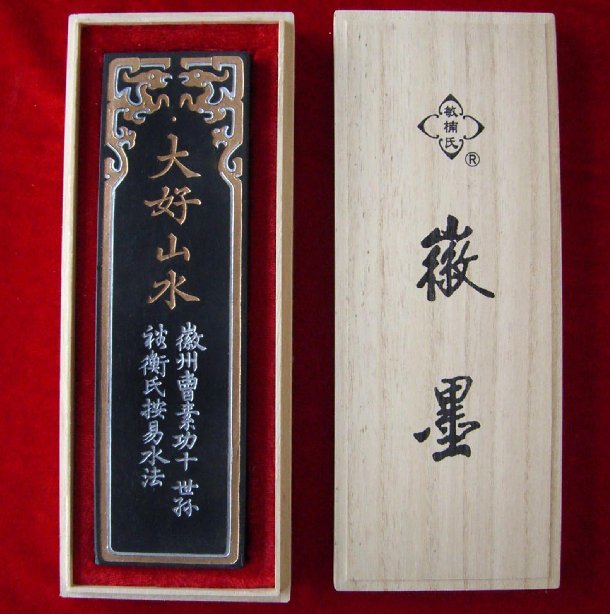
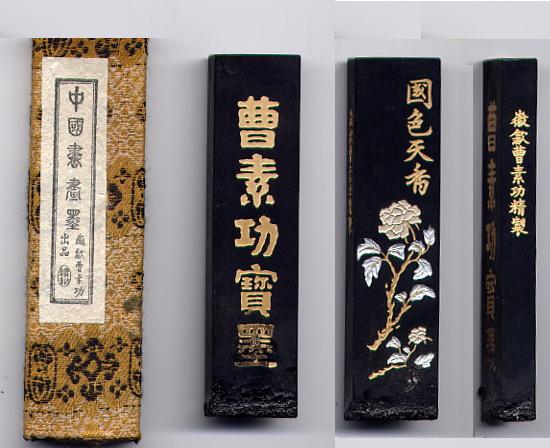
Good quality ink sticks from Tsao Su Gong ( 曹素功 )
|
有時候我提到硯台,有些老師還笑我,這個時代都用墨汁,哪有人像你還在收集硯台。 其實墨法就像血液的成份與氣血的流通,肉眼無法見,但是運動的時候可發揮出來。 有時候我提到〝墨法〞這個詞彙,學生不只無法理解,而且一開始不願意配合,多半認為磨墨很麻煩、沒多少學問,殊不知筆法與墨法乃相輔相成,只顧筆法而不知墨法只會事倍工半多走彎路。
我過了35歲以後,才了解當年資成都老師在我17歲時告訴我墨法一詞的涵義。當時他並沒有特別闡述及示範。等我35歲以後瞭解了,楷書才突飛猛進。以前的筆法結構從20歲左右到現在大致沒有變,進步大多憑了解墨法。 我也悟出了自己的話: 如果一個人學書法沒有老師指導,也沒有看書法理論的書籍,如果磨墨"摸"對了與用墨對了,進而能闡釋〝墨法〞,等於他把書法理論大部分課題全想通了。〝墨法〞牽連了很多書法理論與技巧的層次。 The term "Ink Methodology" can be applied to both Chinese calligraphy and Chinese brush painting. Not only grinding ink on an inkstone with an ink stick is involved, the term contains many other technical, aethetical, and theoretical issues. I heard this term at age seventeen while I was living in my teacher's calligraphy apartment-studio... I began to understand the term after age thirty-five and made more progress based on the understanding rather than more practice hours.
|
Inkstones (or ink slabs) are vessels in which ink is ground with an ink stick. Among the numerous inkstones produced in China, the most outstanding four types are:
|
(2) She Inkstone ( 歙硯 ) (3) Yaohe Inkstone ( 洮河硯 ) (4) Chengni Inkstone ( 澄泥硯 )
|
|
|
|
Among them, Duan Zhou and She Zhou inkstones are unanimously agreed to be the best and thus they are very expensive. A top quality Duan Zhou or She Zhou inkstone with artistic carving of landscapes can be as expensive as U.S. $10,000 or more. It is said that in ancient times when people were digging stones in the rivers of Duan Zhou to make the inkstones, the workmen had to be naked while the governors were observing for any theft. Recently as Taiwanese businessmen had bought out the rights to explore the Duan Zhou stones, the prices of Duan Inkstones tend to increase a lot in the market. Though Duan Inkstones are usually ranked before the other three, some say certain She Inkstones are not inferior to Duan Inkstones and may be even superior since there are many grades of both Duan and She Inkstones. In the West, it is not easy to acquire a good and authentic Duan Zhou or She Zhou inkstone at a fair price.
|
Grinding on Duan Inkstone is very smooth and has minimal sound, and gets ink ready in a shorter time.
|
Grinding on She Inkstone is very smooth and has minimal sound, and gets ink ready in a shorter time.
|
|
Various beautiful and rare inkstones
|
There are inkstones for the sake of decoration, collection, and practice. For the sake of practice, one should choose an inkstone with less beautiful carvings since carvings are sometimes used to add value to stones that are not top qualities. For beginners, a plain inkstone of the size of a hand with less carving is recommended. A beginner's inkstone should neither be as small as in this set nor as huge as a decorative one. Yishui Inkstones ( 易水硯 ) are also among the top ranks in China and their affordable prices are appealing to many beginners or first time buyers.
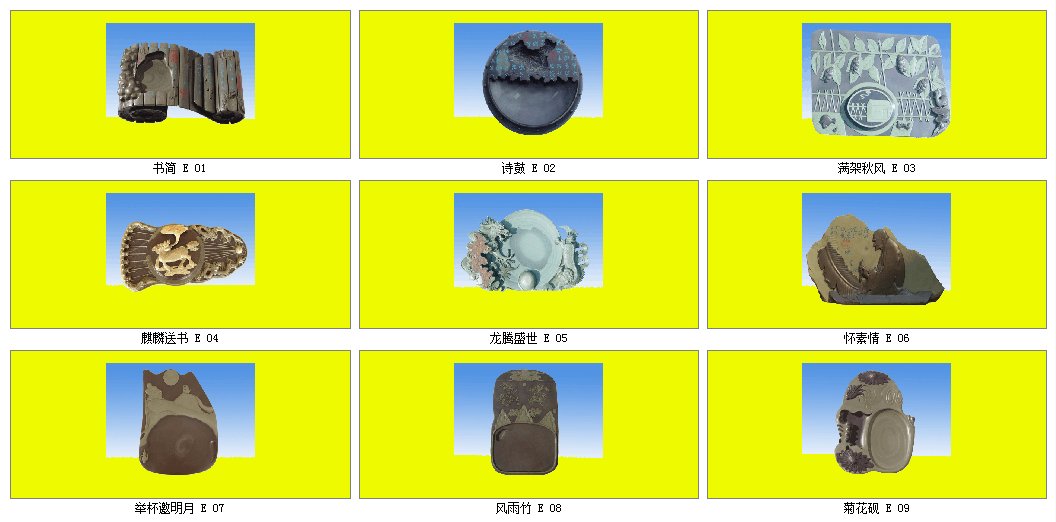
Collectable Yishui Inkstones ( 易水硯 ) from www.jinsanbao.com/main.asp
|
|
|
|
Medium
Sized Yishui Inkstones ( 易水硯
) |
Students Inkstone from www.acornplanet.com |
Too much water used in grinding ink
It's a serious mistake for beginners as well as experienced practitioners to think that grinding ink is unnecessary and unimportant.
Throughout the Chinese history, master calligraphers and painters have spent their thoughts on different ways and possibilities to grind ink sticks on their ink slabs. They have also studied and experimented the timing and duration between touches of brush tip and the paper, various pressures to grind ink sticks, percentage of water and grinding time, and so on.
A combination approach using both grinding and bottled ink
The quality of grinded ink will surely affect the quality of brushstrokes from technical, philosophical, and spiritual perspectives. The Ink Methods ( 墨法 ) are closely related to Brush Treatments ( 筆法 ) and further progress in making fine brush strokes rely on the coordinated movements of the practitioner's Palm Methods, Finger Methods, Wrist Methods, Shoulder Methods, and even body postures. Chinese calligraphy theorists say, "The secrets of Ink Methods just come out of the brush strokes; the refinement of brush strokes relies on the Ink Methods." ( 墨法之妙,全從筆出;筆法之精,墨法之功。 ) A finely executed brush stroke with varieties of ink nuances will look more lively than poorly grinded ink or ungrinded bottled ink.
|
|
|
|
|
|
The ancient Chinese said basically there are five colors of grinded ink ( 古人有墨分五色之說 ). The five main descriptions of ink colors are: burnt ink, thick ink ( 濃墨 ), dry light ink, light ink ( 淡墨 ), and wet ink. When a calligraphy work is done with proper Ink Methods, it will look more rhythmic, lively, and spirited; while with the bottled liquid ink, it will look monotonous and less lively.
|
Disadvantages of Bottled Ink (Liquid Ink) without Grinding |
|
Bottles of liquid ink vary enormously in quality, and even some famous brands are poor if stored for longer periods of time. With the poorer kinds it is difficult to obtain subtle shades by dilution. Bottled ink may also contain preservatives or chemicals that will damage the brush hairs eventually. Its residues are more difficult to wash away, and in a shorter time will compromise our executions and results of Brush Treatments. Even for some famous brands of bottled ink, the processes of mounting calligraphy into a scroll may result in the so-called Running Ink ( 跑墨 ). The ink will look like bleeding or spreading beyond each stroke and may or may not be fixed. The following example of dragon was written with one of the most famous brands of bottled ink which is not made in a conventional way since it contains something that should not be used to make an ink stick. (The brand name is kept anonymous here.) While with grinding quality ink stick, the calligraphy can be mounted even right away without the disastrous Running Ink.
|
A mounted example of Living written with well grinded ink on Shuan Paper
|
Running Style written on sized, single Shuan Paper. The paper is sized with alum to decrease the absorbency of ink so that it permits the brush to stay for a longer time on the paper without causing the ink to spread. The ink was grinded on a top quality Duan Zhou Ink Stone ( 端州硯 ) with a high quality ink stick of the Tsao Su Gong brand ( 曹素功 ). The fine brush was made by Yang Zheng-Hua ( 楊振華 ) in Shanghai. The top qualities of the Four Treasures help to write more controlled and smooth brushstrokes. Without patiently grinding the ink to a desired level, even the best tools of the Four Treasures will be of no avail. |
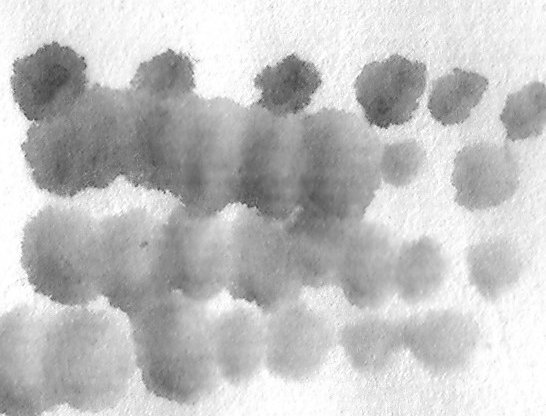
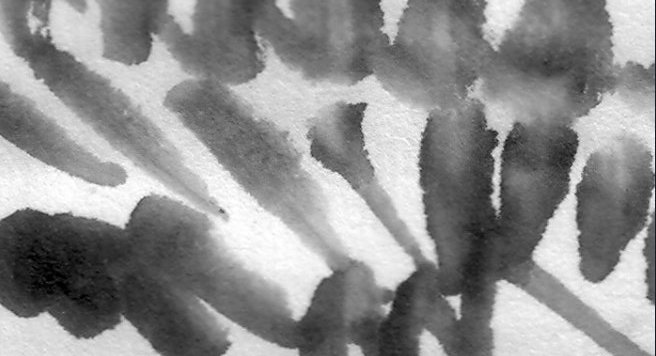
Experiments of ink colors by a famous Chinese brush painter in Beijing who also makes and burns his ink sticks
The ancient Chinese also advised "never let a brat handle an inkstone" and "wash inkstone daily after use." Unused ink should better not be left on the inkstone overnight, otherwise it becomes Overnight Ink which is commonly referred to as "宿墨". "宿墨" also refers to unused ink dried on the inkstone; it does not necessarily have to be "overnight." "宿墨" can mean Overnight Ink or simply dried ink.
Overnight Ink is not usually appropriate for practicing calligraphy, especially for beginners. However, Overnight Ink or dried ink can be used to create some special effects in Chinese Brush Painting. Thus, using Overnight Ink (or dried ink) is also one of the Ink Methods. Though some experienced calligraphers also use Overnight Ink to create some special effects in their strokes, beginners are advised to wash their inkstones right away when they do not intend to use it for a while, say a few hours.
Overnight Ink staying on the inkstone should be washed away before practicing again.
A final advice is simply to grind an ink stick and experiment different possibilities of the Ink Methods. Without grinding, one's abundant knowledge, artistic insight, and competent skills of Chinese calligraphy will be of no avail or compromised.
|
Convenience Ink 方便墨 - Chinese Painting & Calligraphy |
|
|
|
At
night when I come home late or during busy days, sometimes I use
inexpensive bamboo paper and convenience ink to warm up and practice
painting for a while. Chinese say 拳不離手
(fists do not get away from a martial artist's hands) and
曲不離口 (singing songs do not get away from a
singer's mouth). The more we get used to practice, the more it becomes
easier.
|